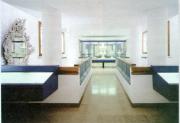| . |
 |
During the 1770s the
widespread use of terraglia, (a mixture obtained
in England from the end of 1725, which had a
white body and subsequent low costs) led to the
unforeseen competition between Italian maiolica
and porcelain: once more the Antonibon factory
proceeded under the management of Gio Maria
Baccin who, in 1786, succeeded in formulating an
imitation of the English clay. |
At the beginning
of the eighteenth century, despite the hard
political-economic crisis, a few manufacturers in Nove
became prosperous through the production of terraglia:
the manufacture of luxurious wares for the nobility was
replaced in favour of a wider and more modest market
which appreciated the new subjects and techniques, now
known as "popular ceramics".
Around 1860-1865
another era known as "Artistico or Aulico or
NeorococÚ" (Artistic-Courtly and Neorococo) was
stimulated by the competition between foreign
manufacturers at the various international exhibitions.
|